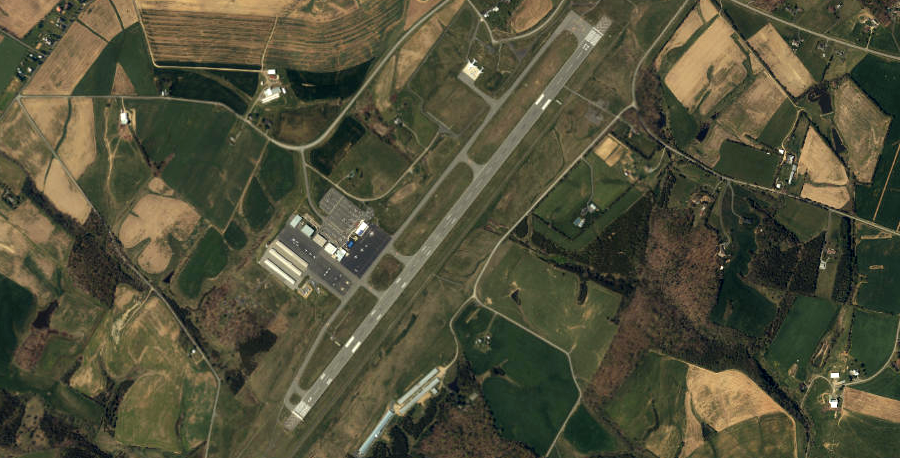
Shenandoah Valley Regional Airport (SHD) is the smallest airport in Virginia with scheduled passenger service
Source: ESRI, ArcGIS Online

Shenandoah Valley Regional Airport (SHD) is the smallest airport in Virginia with scheduled passenger service
Source: ESRI, ArcGIS Online
The General Assembly created the Shenandoah Valley Joint Airport Commission in 1956. Representatives from Rockingham County, Augusta County, and the cities of Harrisonburg, Waynesboro and Staunton have managed the airport since it opened in 1958. In 1988, the commission adopted its current name of the Shenandoah Valley Airport Commission.1
No jurisdiction east of the Blue Ridge is represented on the commission, since the counties east of the mountains and the City of Charlottesville are oriented towards the competing Charlottesville-Albemarle (CHO) airport.
In 1958, when the new airport was built in the Shenandoah Valley, the two sides of the mountains were more isolated than today. Even after completion of I-64 through Afton Gap in 1971-72, a trip across the Blue Ridge can be difficult due to fog and ice in the mountain gaps. The difficulty of getting to Charlottesville is the primary justification for maintaining scheduled passenger service to Shenandoah Valley Regional Airport (SHD), where the costs of operating passenger airplanes exceeds the revenue generated every year.
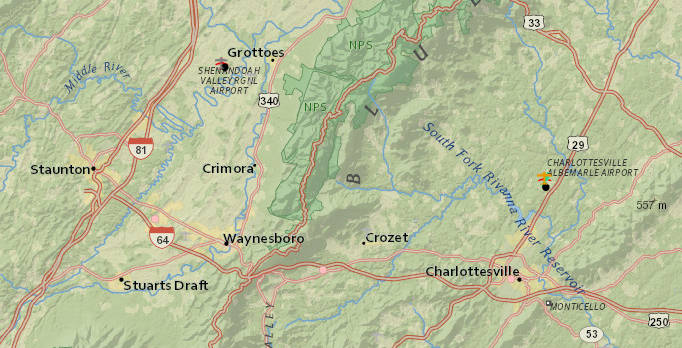
Shenandoah Valley Regional Airport (SHD) and Charlottesville-Albemarle (CHO) Airport are separated by the barrier of the Blue Ridge, including Shenandoah National Park
Source: ESRI, ArcGIS Online
Scheduled service by a commercial carrier started in 1960. Piedmont Airlines offered commercial passenger service from the Shenandoah Valley Regional Airport (SHD) to Roanoke and Washington National Airport, now Reagan National Airport. Piedmont had proposed to provide service to the Staunton area in 1958, but the Federal government's Civil Aeronautics Board rejected the application. It ruled that the existing airport serving Staunton, which was located at the current site of the Augusta County Government Center in Verona, was not suitable.
Local officials reacted by organizing the Shenandoah Valley Airport Commission and building the Shenandoah Valley Regional Airport (SHD). The new facility sat idle for a year before the Civil Aeronautics Board approved the request to start scheduled passenger service.
Demand, especially for freight traffic, was sufficient to justify expanding the original airport's infrastructure. In the 1960's, a new terminal replaced the farmhouse that had been moved to the airport and converted into the original facility, and the runway was extended twice. Prior to the first runway extension, on hot days Piedmont occasionally had to force some passengers to get off a plane to stay within weight limits. 2
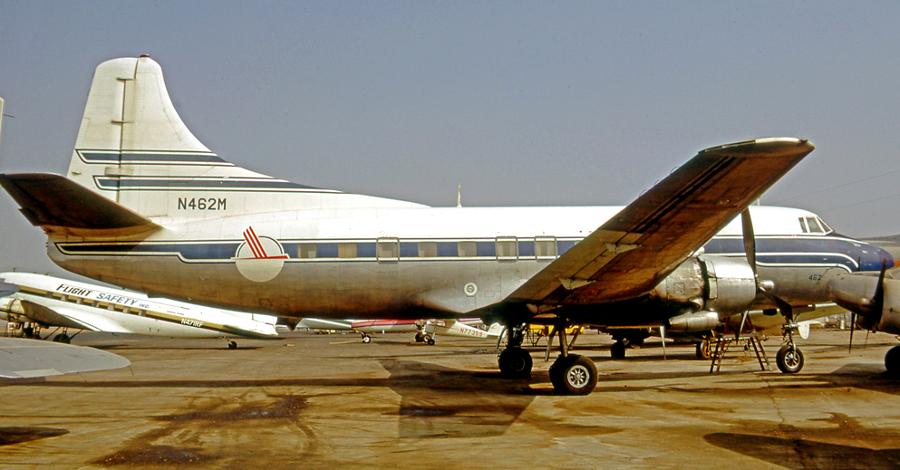
occasionally passengers would have to deplane on hot days to stay within weight limits, when Piedmont Airlines flew under-powered Martin 404 turboprops into Shenandoah Valley Regional Airport (SHD)
Source: Wikipedia, Piedmont Airlines
The only fatal crash of a passenger plane at Shenandoah Valley Regional Airport (SHD) occurred in 1985. The two crew members and 12 passengers all died when the pilots of Henson (Piedmont) Flight 1517, coming from Baltimore-Washington International (BWI), used the wrong navigation beacon on approach. The plane crashed about six miles east of the airport into Hall Mountain, on the west side of the Blue Ridge.3
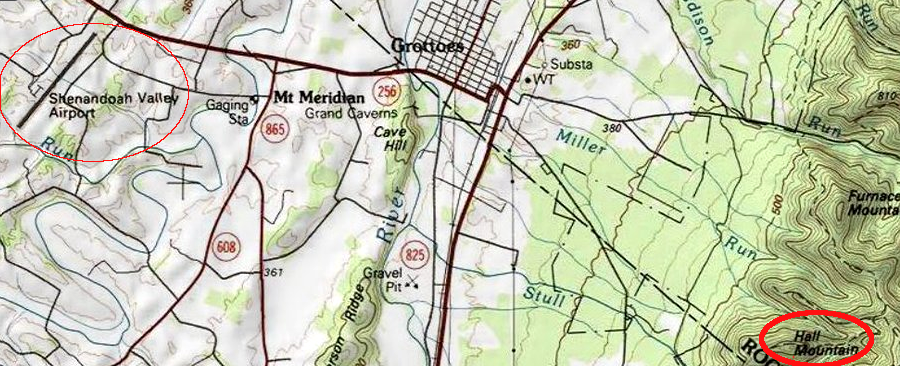
all 14 people on Henson (Piedmont) Flight 1517 died when it crashed on Hall Mountain in 1985, in the one fatal crash of a scheduled airliner at Shenandoah Valley Regional Airport (SHD)
Source: ESRI, ArcGIS Online
By 1989, when US Airways acquired Piedmont, the regional carrier was providing flights from the Shenandoah Valley to Piedmont's hub in Baltimore. Service continued, and it was code-shared flights with US Airways under the US Airways Express brand. Competition came to the Shenandoah Valley Regional Airport (SHD) after a different regional carrier offered flights to the United Airlines hub at Dulles International Airport (IAD). Flights to Dulles were code-shared under the United Express brand. That service to Dulles was dropped in 1996, then renewed in 2000.4
On September 10, 2001, Atlantic Coast Airlines, operating as United Express, was scheduling four roundtrip flights to Dulles International Airport (IAD) every day. Atlantic Coast Airlines flew 19-seat twin-turboprop Jetstream 32 aircraft. Its competitor Midwest Airlines, operating as US Airways Express, provided four roundtrip flights daily and two additional flights on weekends to Pittsburgh International Airport (PIT). Midwest Airlines flew 19-seat Beech 1900 planes.5
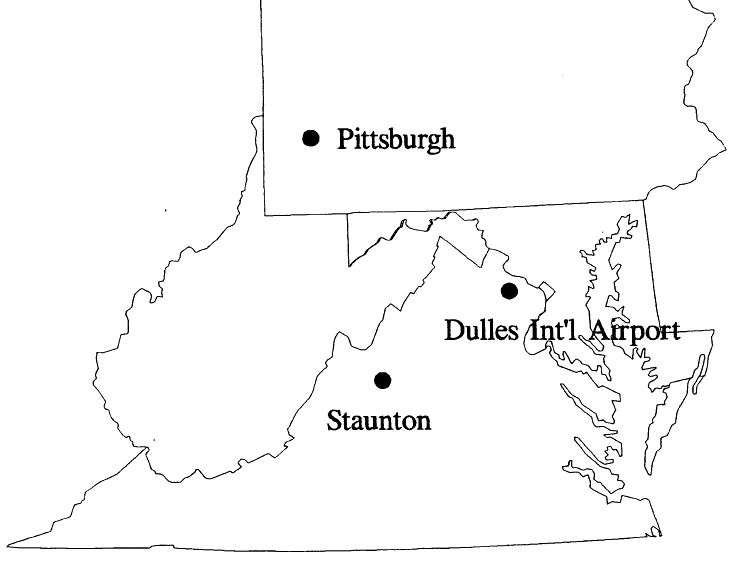
before 9/11 depressed the airline industry, the Shenandoah Valley Regional Airport (SHD) near Staunton had daily service to both Pittsburgh and Dulles airports
Source: US Department of Transportation, Order Allowing Suspension of Service, Docket OST-2001-10628-3 (Appendix)
The regional carriers chose to schedule multiple flights each day with small planes, rather than aggregate customers into larger aircraft. Federal regulations required the extra cost of a flight attendant if planes carried more than 19 passengers. In addition, small turboprops were more cost-effective for the 170 mile flight to Pittsburgh and 135 mile flight to Dulles.6
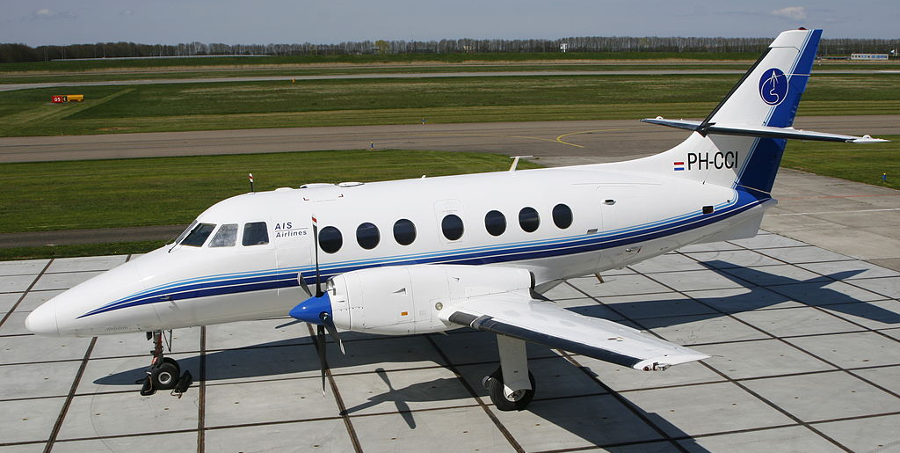
turboprops such as the Jetstream 32 serviced Shenandoah Valley Regional Airport (SHD) until a new carrier, ViaAir, chose to use jets in 2016
Source: Wikipedia, AIS Airlines
On September 12, 2001 - the first day after the 9/11 terrorist attacks, when all flights were grounded - Atlantic Coast Airlines notified the US Department of Transportation that it wanted to end service to Dulles International Airport (IAD).
Federal approval was required. Before airlines were deregulated starting in the 1970's, the Civil Aeronautics Board determined which carriers could fly to specific airports, controlling competition and even fares charged by different airlines. Carriers had to provide two daily round trips to each city they were authorized to serve.
Deregulation ended many Federal mandates, but created the risk that smaller airports generating low profits would lose all service. In 1978, the US Congress required the Civil Aeronautics Board and (after 1985) the US Department of Transportation to define Essential Air Service requirements and subsidize airlines to maintain a minimum level of service to communities that met certain criteria.
For Shenandoah Valley Regional Airport and about 140 other remaining Essential Air Service airports, the US Department of Transportation:7
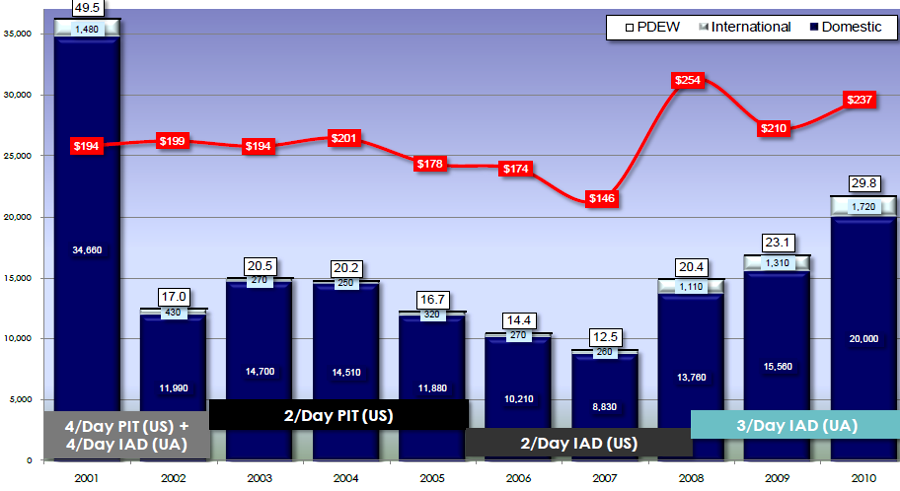
before 9/11, the Shenandoah Valley Regional Airport had more flights to more destinations, at lower cost, and more passengers boarding or disembarking per day (PDEW)
Source: Shenandoah Valley Regional Airport, Application for Federal Support for Current Essential Air Service (EAS) via: Advertising/Marketing Program (Figure 1)
The Essential Air Service determination for Staunton called for two round trip flights each day to Washington, with a total of 66 seats. Between 1994-1996, the Federal government provided a subsidy to ensure continued service at Shenandoah Valley Regional Airport (SHD).
The 2001 proposal by Atlantic Coast Airlines to drop its United Express flights to Dulles triggered another review by the US Department of Transportation, because Shenandoah Valley Regional Airport (SHD) would no longer have the minimum service defined as "essential." The US Airways Express carrier (Air Midwest) had capacity for only 57 passengers, and flew to Pittsburg instead of Washington.
The 9/11 events transformed air transportation, and the US Department of Transportation adjusted the Essential Air Service requirements for Staunton. The Federal agency determined that service to Pittsburgh would maintain the essential link to the national air transportation system, and that seats for 57 passengers exceeded demand. That determination allowed Atlantic Coast Airlines to drop its United Express flights to Dulles, and for the US Airways Express carrier (Air Midwest) to get a Federal subsidy to continue service to Pittsburgh.
In 2002, Colgan Airways won the contract as the Essential Air Services carrier and replaced Air Midwest. Colgan required a subsidy of $623,667 per year, over $100,000 more than Air Midwest, but business leaders near Staunton preferred that small airline. The US Department of Transportation decided to pay the extra amount:8
The dreams of returning to self-sufficiency have not been realized, and servicing Shenandoah Valley Regional Airport (SHD) has not been profitable. Ever since 9/11, the airport has required a Federal subsidy to retain a carrier.
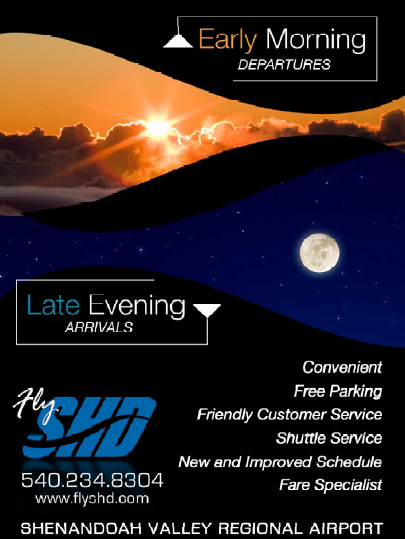
advertising has not been sufficient to grow passenger traffic and eliminate the need for an Essential Aircraft Service subsidy to maintain scheduled passenger service at Shenandoah Valley Regional Airport (SHD)
Source: Shenandoah Valley Regional Airport, Advertising/Marketing In Support of Colgan Air Essential Air Service
to/from Washington Dulles International Airport (Table 27)
Colgan maintained service as US Airways Express to Pittsburg, code-sharing with US Airways, through 2004. In 2005, service to Pittsburgh International Airport (PIT) was cancelled, so Colgan Airways switched its US Airways Express flights to Dulles International Airport (IAD).

Shenandoah Valley Regional Airport generates the lowest number of enplanements (commercial passengers getting on planes) in Virginia
Source: Federal Aviation Administration (FAA), CY 2012 Passenger Boarding and All-Cargo Data
Dulles was a major hub, but US Airways had few connecting flights at Dulles compared to its hub in Pittsburgh. The number of passengers using Shenandoah Valley Regional Airport (SHD) dropped dramatically until Colgan Airways switched its code-share arrangement to United.9
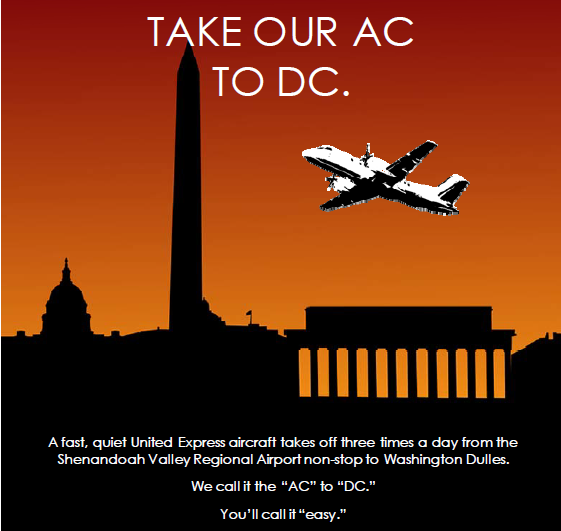
Colgan Airways flew turboprops to Dulles, so it saw benefits in advertising the comfort of air-conditioned cabins
Source: Shenandoah Valley Regional Airport, Advertising/Marketing In Support of Colgan Air Essential Air Service
to/from Washington Dulles International Airport (Table 6)
Colgan Airways operated from Shenandoah Valley Regional Airport between 2002-2012, code-sharing with US Airways and then United Airlines. The business never made a profit sufficient to end the Federal subsidy, especially after a shift in 2008 from the 19-seat Beechcraft 1900 to the larger 34-seat Saab 340 turboprops. The airport calculated the load factor had to be 50-60% between Dulles International Airport (IAD) and Shenandoah Valley Regional Airport (SHD), but the load factor declined to just 16% in 2009 as the economic recession deepened.
In 2012 Colgan Airways petitioned the US Department of Transportation to release it from the contract. As in 2002, the US Department of Transportation made the incumbent carrier extend its service until a new carrier was awarded an Essential Air Service contract (with a new subsidy amount) and assumed responsibility.10
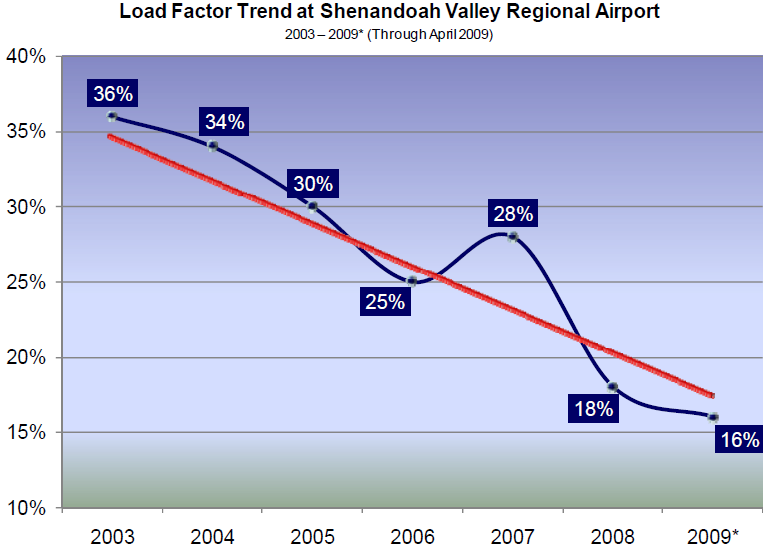
since it acquired the contract in 2004, Colgan Airways' planes were more than half-empty between Dulles International Airport (IAD) and Shenandoah Valley Regional Airport (SHD)
Source: Shenandoah Valley Regional Airport, Advertising/Marketing In Support of Colgan Air Essential Air Service
to/from Washington Dulles International Airport (Table 20)
Silver Airways replaced Colgan Airways in 2012 as the Essential Airline Service contract carrier. Silver Airways also used a code-share with United Airlines, so United Express service continued uninterrupted from Shenandoah Valley Regional Airport (SHD) to Dulles International Airport (IAD).11
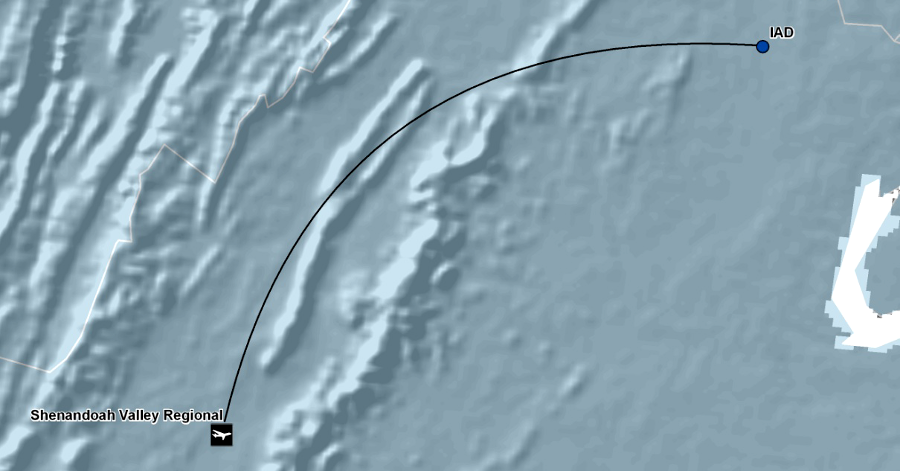
flights continued to Dulles in 2012 when Silver Airways replaced Colgan Airways as the Essential Air Service carrier, but the 2016 change in carriers resulted in a shift of destinations
Source: Shenandoah Valley Regional Airport, Advertising/Marketing In Support of Colgan Air Essential Air Service
to/from Washington Dulles International Airport (Table 5)
In exchange for maintaining regular connections to the designated hub airport (Dulles), Silver Airways was eligible to receive over $3 million annually in Essential Air Service subsidies. In 2011, that subsidy was roughly $140 for each of the 12,000 passengers that flew in or out of the airport.12
Frontier Airlines entered the market in late 2012, without a subsidy. It briefly offered service from Shenandoah Valley Regional Airport (SHD) to Orlando, Florida. The airline sought to mimic Allegiant Air by connecting underserved smaller markets to vacation centers, after the economy had recovered from the 2008 recession and business/tourism traffic increased.
Frontier Airlines cancelled its operations after the 2012-13 winter and never returned. The model worked for Allegiant Air in Newport News and then Richmond, but was not profitable from the low-population Shenandoah Valley. Many of the potential customers for Frontier often drove to Washington, Charlottesville, or Richmond to fly south with one less stop and with lower fares, as revealed in a traffic "leakage" study:13
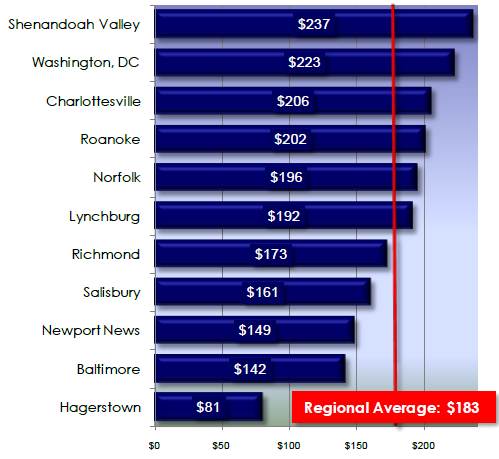
in 2010, average one-way fares at the Shenandoah Valley Regional Airport were 30% higher than at competing airports
Source: Shenandoah Valley Regional Airport, Application for Federal Support for Current Essential Air Service (EAS) via: Advertising/Marketing Program (Figure 3)
Silver Airways operated as United Express to Dulles International Airport (IAD) from 2012-2016. The US Department of Transportation issued a new Essential Air Service contract in 2016, and received five bids to provide subsidized service. Offers ranged from 50-seat jet service to Hartsfield-Jackson Atlanta International Airport (ATL) at the high end to an eight-seat plane flying to Baltimore-Washington International (BWI) Airport at the low end.
ViaAir won the Essential Air Service contract. It offered service to Charlotte Douglas International Airport (CLT) and Orlando/Sanford, Florida (SFB), rather than to Washington.

Silver Airways stopped flying from Shenandoah Valley Regional Airport (SHD) to Dulles International Airport (IAD) at the end of November, 2016 and Via Air began flying to Charlotte and Florida
Source: Silver Airways, Route Map and Timetables and Timetable September 1 - October 3, 2016
The 2016 shift in Essential Airline Service carrier from Silver Airways to ViaAir reduced passenger traffic at Dulles International Airport (IAD). Severing the United Express connection with the Northern Virginia hub was not viewed as a major loss by United Airlines. It had not invested in marketing its services within the catchment area of the Shenandoah Valley Regional Airport (SHD). In 2011, United was able to retain only 31% of the customers who flew from Staunton to Washington, and almost 70% of Shenandoah Valley customers connected at Dulles to flights provided by competing carriers.
The 2016 shift from Dulles International Airport (IAD) to Charlotte Douglas International Airport (CLT) increased customers' options for making connections, even though ViaAir started service without a code-share arrangement associated with a major airline.
During 2012-16, when Silver Airways held the Essential Air Service contract, United and other domestic carriers had reduced service at Dulles. In 2016, Charlotte offered the sixth busiest airport in the world, with more than 140 nonstop destinations to domestic and international airports in Europe, the Caribbean, Central America, and Mexico. Dulles offered 125 domestic and international destinations.14
The executive director of the Shenandoah Valley Regional Airport noted:15
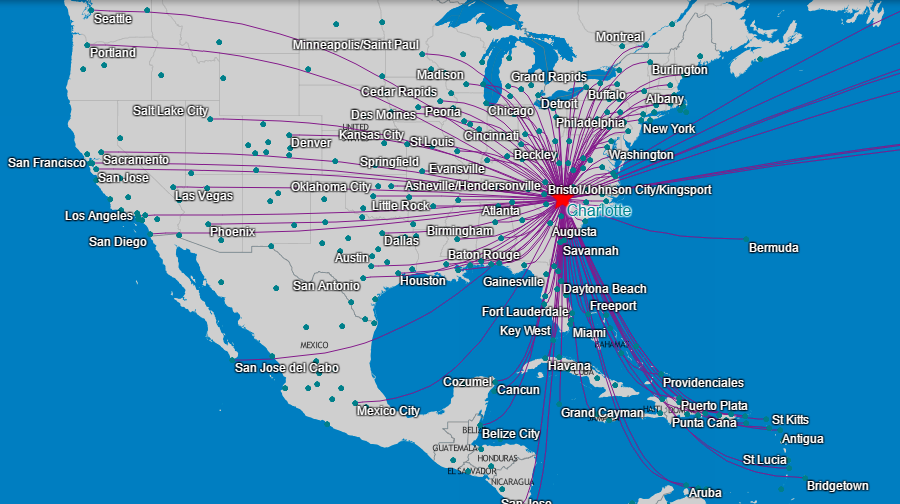
the 2016 switch to Charlotte Douglas International Airport (CLT) gave Shenandoah Valley Regional Airport (SHD) customers connections to 140 destinations
Source: Charlotte Douglas International Airport, Route Map
ViaAir flew only jet aircraft into Shenandoah Valley Regional Airport (SHD). Frontier had used jets in 2012-13, but flew only on Tuesdays, Fridays, and Sundays. The airport proudly announced:16

Via Air provided Shenandoah Valley Regional Airport (SHD) the first commercial air service using jets
Source: Via Air, About Us
The start-up was not smooth. By February 2017, the ViaAir service was so unsatisfactory that the U.S. Department of Transportation threatened to cancel the Essential Air Service contract and award it to another carrier. The Federal agency claimed ViaAir was cancelling scheduled flights in order to use its aircraft for more-profitable charter operations.
In addition, flights to Charlotte were delayed so long that passengers missed connections. Since ViaAir had no code-sharing arrangement, delays meant that passengers had to pay last-minute change fees to other airlines to adjust their flights from Charlotte to their final destination.17
The Staunton newspaper editorialized that the free parking at Shenandoah Valley Regional Airport (SHD) was not sufficient to attract customers if the air carrier's service was not satisfactory:18
Via Air expanded service and added two flights a week to Orlando, but struggled to provide reliable flights to Charlotte so customers could make connections. In July 2017, the airport asked the US Department of Transportation to replace Via Air by re-bidding the contract for Essential Air Service. The ViaAir contract was supposed to run for two years, but after only a few months of service the airport commission asked for a change.
The Executive Director for Shenandoah Valley Regional Airport (SHD) reported that half of Via Air's flights were late or cancelled.19
The Federal government responded within two weeks, issuing a re-bid for carriers who could replace Via Air. The process allowed a new carrier to fly to a different airport than Charlotte. As reported by the local paper:20

Via Air advertised the number of connections at Charlotte, but airport officials said Via Air's flights were too unreliable for passengers to make those connections
Source: Shenandoah Valley Regional Airport (SHD), Airline Service
In November 2017, the US Department of Transportation approved SkyWest as the replacement carrier, with service starting April 1, 2018. The Shenandoah Valley Airport Commission recommended that new airline over four other proposals. SkyWest proposed to fly 50-passenger jets to Washington-Dulles International Airport (IAD) and Chicago O'Hare International Airport (ORD), destinations which are hubs for United Airlines.
SkyWest proposed to operate as United Express. That meant passengers flying out of Shenandoah Valley Regional Airport (SHD) could purchase code-share tickets to destinations beyond the two airports where SkyWest planes landed. That prevented a repeat of the problems for ViaAir passengers who missed their flights at Charlotte Douglas International Airport (CLT) and had to pay change fees to re-book flights to their final destinations.
Other bidders had proposed flying to Baltimore/Washington International Airport, Hartsfield-Jackson Atlanta International Airport (ATL), and Charlotte Douglas International Airport (CLT). Via Air did not submit a bid to continue its service to Charlotte.
Passenger traffic increased after SkyWest replaced Via Air in April, 2018. The airline's flights to Chicago originally stopped in Lewisburg, West Virginia. By July, SkyWest concluded that there were enough customers from Shenandoah Valley Regional Airport to eliminate the stop and schedule non-stop flights directly to and from Chicago. In October, 2018, SkyWest began operating direct flights from Shenandoah Valley Regional Airport to Chicago.21

United Airlines began in December, 2017 to book flights from Shenandoah Valley Regional Airport (SHD) as of April 3, 2018
Source: United Airlines
Shenandoah Valley Regional Airport is now classified as Commercial Service, NonPrimary, Non-Hub by the Federal Aviation Administration in the National Plan of Integrated Airport Systems. Until 2016, it had been designated as a Commercial Service, Primary, Non-hub airport. That change reflected the reduction in passenger boardings (the sum of "enplanement" and "deplanement" actions) below the 10,000/year threshold for a Primary airport.22
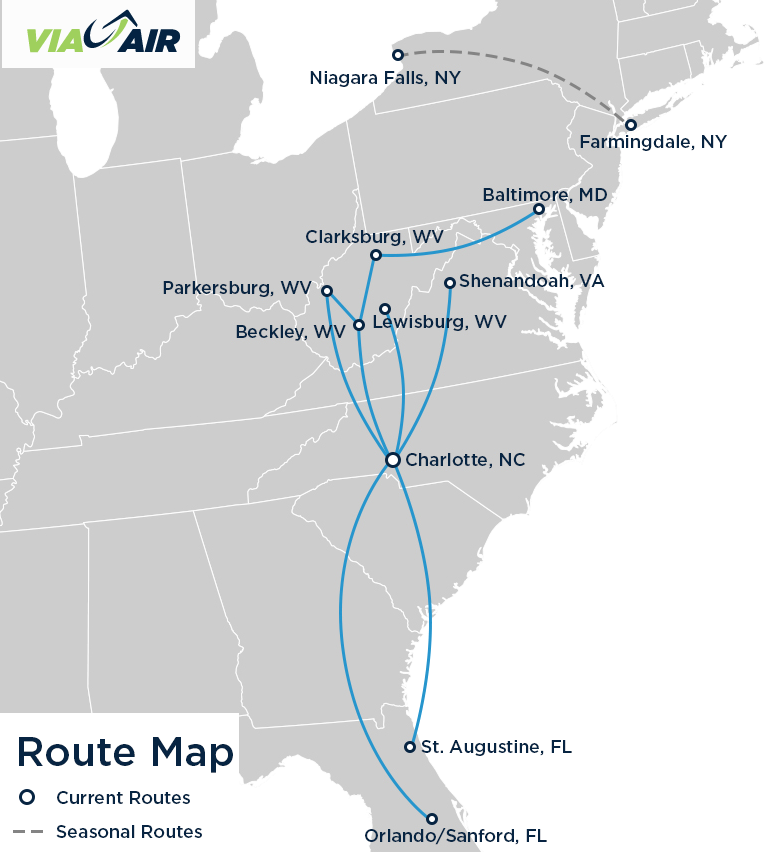
at the end of 2016, Via Air began flying from Shenandoah Valley Regional Airport (SHD) to Charlotte and Florida
Source: Via Air, Route Map
The airport is located in a rural area with low population density. The nearest communities are Weyers Cave, Grottoes, and Mount Sidney. Between them, the population barely exceeds 5,000 people. The City of Waynesboro has about 20,000 residents, the City of Staunton has about 25,000 residents, and the City of Harrisonburg has about 50,000 people.23
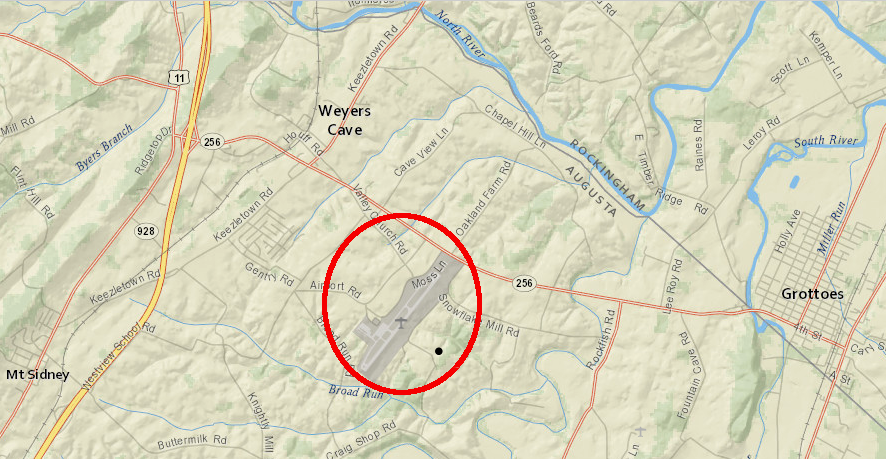
Shenandoah Valley Regional Airport (SHD) is located in a rural area of Augusta County
Source: ESRI, ArcGIS Online
The location of the airport was designed to draw from the concentrated population centers in the cities of Staunton, Waynesboro, Harrisonburg, as well as the scattered population within Augusta and Rockingham counties:24
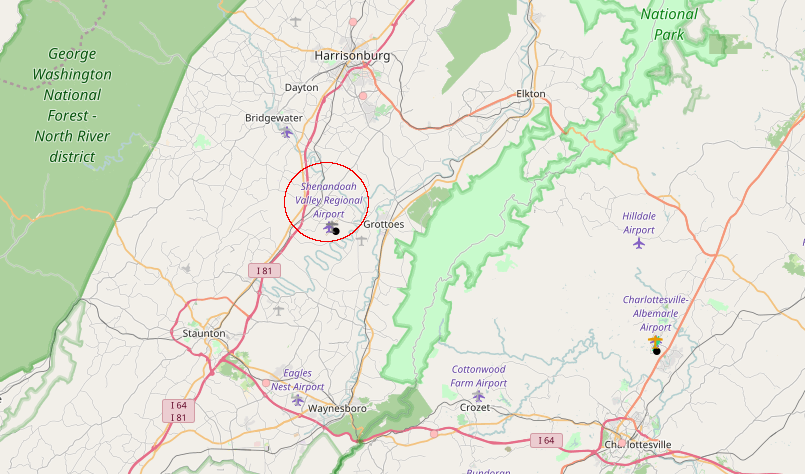
Shenandoah Valley Regional Airport (SHD) is equally convenient to customers in Staunton, Waynesboro, and Harrisonburg - but total population within its one-hour drive time catchment area is limited
Source: ESRI, ArcGIS Online
Its one-hour drive time "catchment area" is limited to the area west of the Blue Ridge from Lexington north to Edinburg. Less than 200,000 people live within a 30-minute drive, and less than 500,000 people within a 60-minute drive.
Airport consultants identify the possibility of attracting customers who live east of Afton Gap and Swift Run Gap and within a 60-minute drive of Shenandoah Valley Regional Airport, but that region is also within the catchment area of the Charlottesville-Albemarle (CHO) airport.
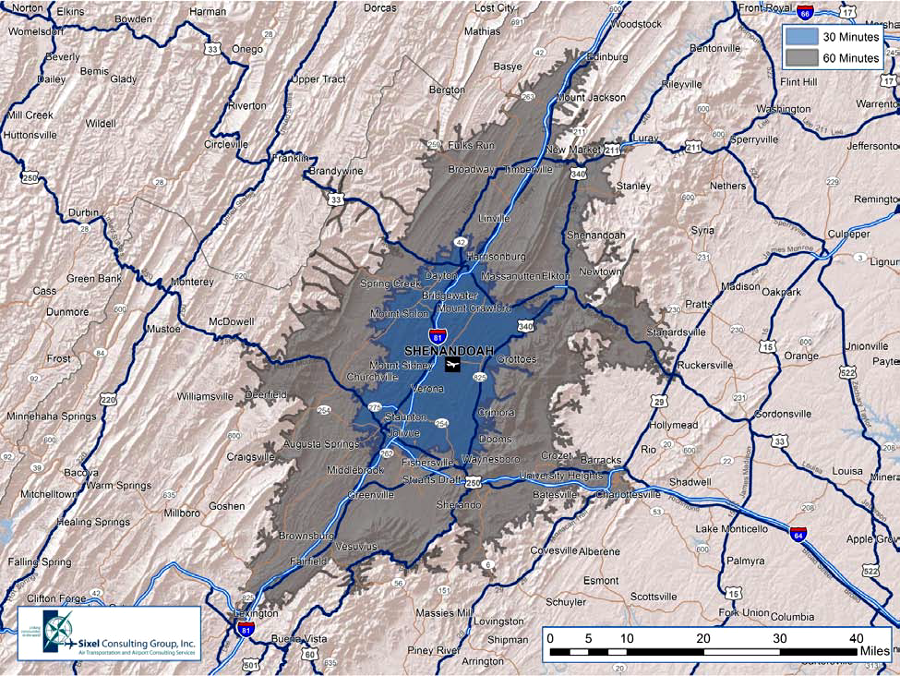
the one-hour drive time catchment area of Shenandoah Valley Regional Airport (SHD) can be divided into 30-minute and 60-minute zones
Source: Shenandoah Valley Regional Airport, Application for Federal Support for Current Essential Air Service (EAS) via: Advertising/Marketing Program
Mountains west of Staunton limit the boundaries of the one-hour drive time catchment area in Highland, Bath, and Alleghany counties to drive to Shenandoah Valley Regional Airport (SHD). For some of those who live on the western border of Virginia, the mountain barriers and the routes of US 220 and I-64 make Greenbrier Valley Airport (LWB) in Lewisburg, West Virginia more convenient.
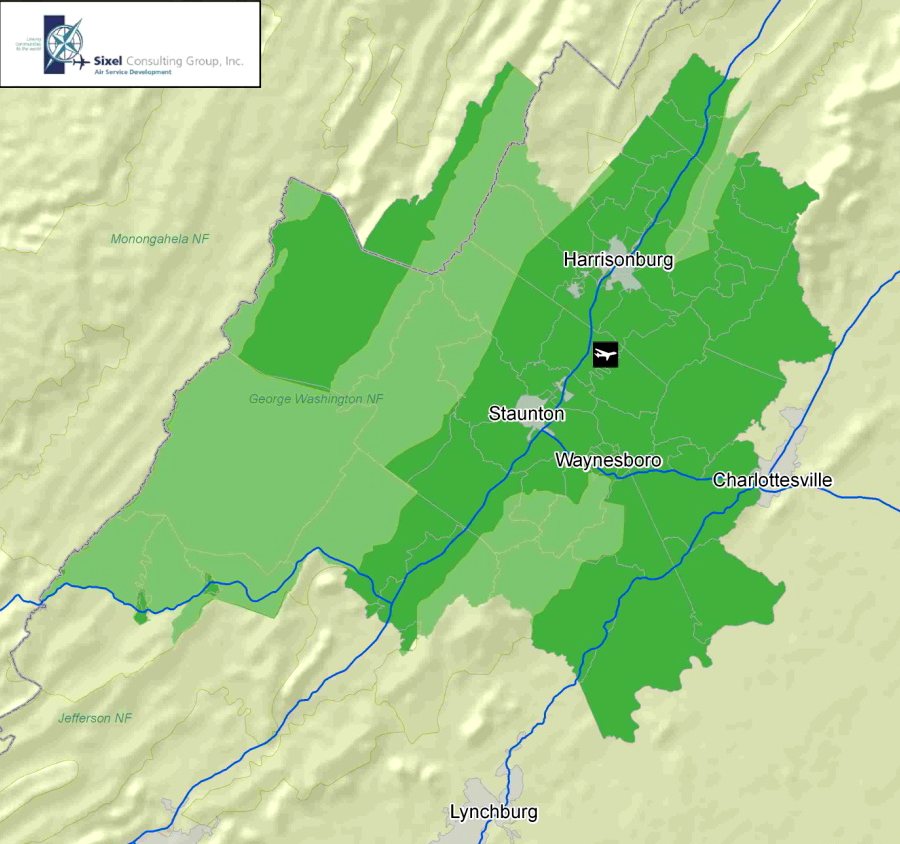
one definition of the Shenandoah Valley Regional Airport (SHD) catchment area includes Highland, Bath, and the northern half of Alleghany County - but much of the western portion is the George Washington National Forest
Source: Shenandoah Valley Regional Airport, Advertising/Marketing In Support of Colgan Air Essential Air Service
to/from Washington Dulles International Airport (Table 1)
Even within the Shenandoah Valley Regional Airport's catchment area between the Blue Ridge on the east and the mountains west of Staunton, there is substantial "leakage" of airline travelers. Interstate 81 leads north to Dulles International Airport (IAD), while I-64 and Route 33 provide access to Charlottesville-Albemarle (CHO) and Richmond International (RIC). As described by the airport:25
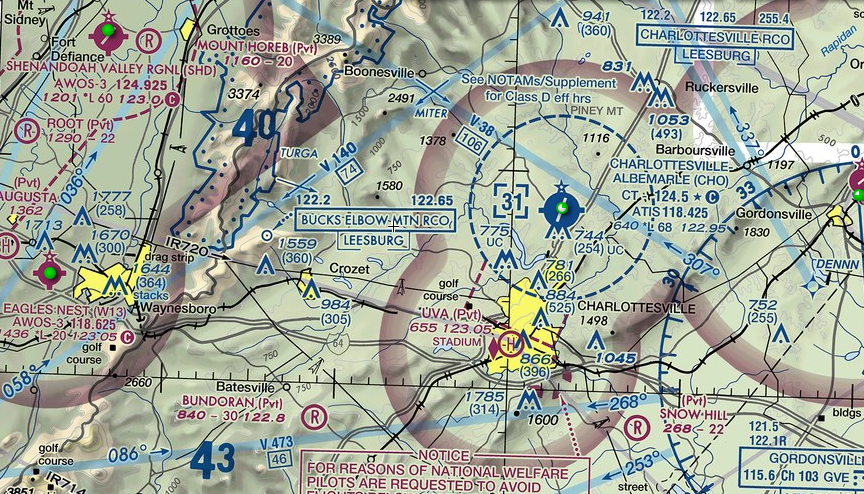
aeronautical chart for area including Charlottesville Albemarle Airport (CHO) and Shenandoah Valley Regional Airport (SHD)
Source: SkyVector
The Shenandoah Valley Regional Airport determined in a 2010 market study that 92% of its potential customers were choosing to fly out of competing airports. In 2011, it sought a US Department of Transportation grant to increase advertising within its catchment area.
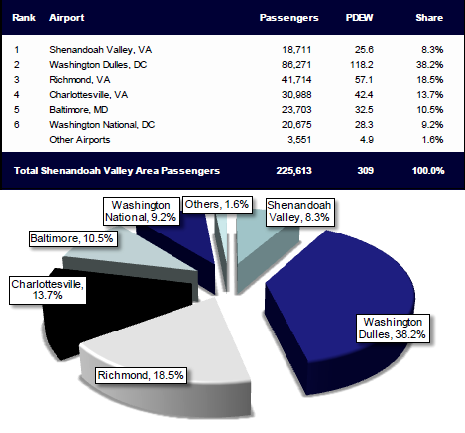
in 2010, most residents in the Shenandoah Valley started their flights at Dulles International Airport (IAD), not the closer Shenandoah Valley Regional Airport (SHD)
Source: Shenandoah Valley Regional Airport, Application for Federal Support for Current Essential Air Service (EAS) via: Advertising/Marketing Program (Figure 4)
The airport claimed it could increase the Passengers Daily Each Way (PDEW) numbers choosing to fly out of the Shenandoah Valley by increasing the willingness of local residents to check the fares. The airport's high-fare reputation was so strong that travelers had simply stopped comparison shopping:26
SkyWest bid on the Essential Air Services contract and committed to start operations in April, 3, 2018 because it expected to have enough passengers to make a profit. Flying as United Express, it scheduled three flights a day on jets capable of carrying 50 passengers. With the new carrier, the airport offered direct flights to Chicago's O'Hare International Airport (ORD) and Dulles International Airport (IAD). Flights were scheduled to facilitate passengers connecting to another plane at those hub airports to reach their final destination.
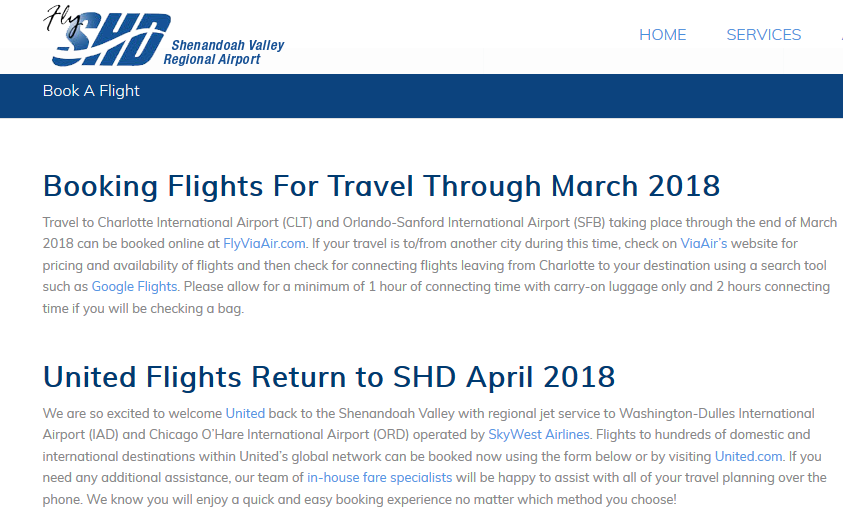
Shenandoah Valley Regional Airport (SHD) switched from ViaAir to SkyWest in 2018
Source: Shenandoah Valley Regional Airport, Book-A-Flight (February 24, 2018)
An aviation expert advised the business community that the region needed to provide enough customers or SkyWest/United would redirect resources to other, more profitable routes. In particular, he noted:27
The SHD Air Service Task Force, "ambassadors" who networked within the regional business community, were successful in generating customers for the airport. In response, United Express increased the number of flights at the end of 2019. Total passenger traffic climbed 150% between 2017-2018, and another 44% in 2019 to reach the highest level in the airport's history. All four corporate size aircraft hangars were leased, and the airport proposed to spend over $3 million to build new ones plus replace the old fuel storage tanks.28

United Express increased the number of flights at the end of 2019
Source: Shenandoah Valley Regional Airport, New United Express Flights Coming to Shenandoah Valley Regional Airport
Also at the end of 2019, James Madison University (JMU) declared Shenandoah Valley Regional Airport (SHD) to be the university's official airport. The ambassadors contacted a wide range of school officials to encourage them to plan trips by starting at the local airport, rather than drive first to Dulles or another competitor.29
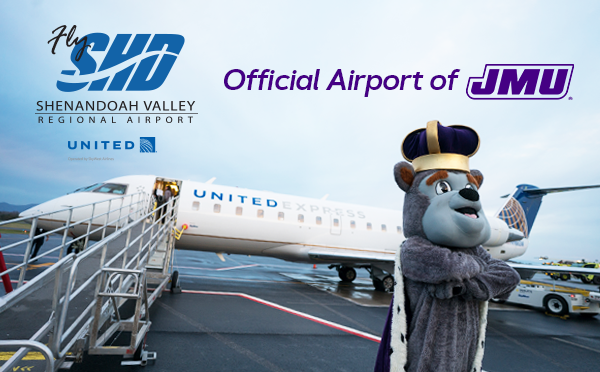
Shenandoah Valley Regional Airport (SHD) and James Madison University formalized their partnership at the end of 2019
Source: Shenandoah Valley Regional Airport, SHD Becomes the Official Airport of JMU!
The essential nature of the Shenandoah Valley Regional Airport (SHD) was reaffirmed by the Federal government in 2020. During the coronavirus pandemic, the US Congress provided $25 billion in the Coronavirus Aid, Relief, and Economic Security (CARES) Act for airlines that would continue service to specific points designated by the US Department of Transportation. The number of flights could be reduced, but some level of service had to be continued in order to qualify for CARES Act funding. The goal was to maintain a skeleton network of air transportation until stay-at-home orders expired, the need for social distancing diminished, and business could resume.
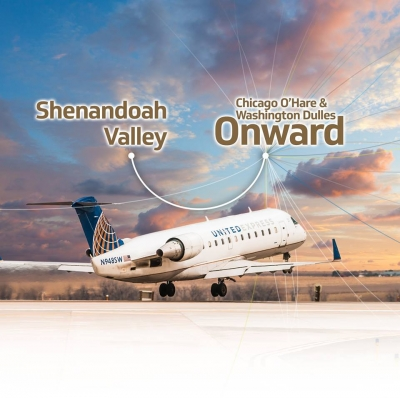
in 2019, SkyWest (operating as United Express) offered direct flights from Weyers Cave to Chicago and Northern Virginia
Source: Shenandoah Valley Regional Airport, Airline Service
The US Department of Transportation required United Airlines to continue service to the Shenandoah Valley Regional Airport (SHD), and for United, Delta, and American Airlines to maintain service to Charlottesville Albemarle Airport (CHO) 50 miles away. In contrast, the Federal agency determined that the Newport News/Williamsburg International Airport (PHF) was not essential. The two airlines using it were permitted to consolidate their operations at just the Norfolk International Airport (ORF), located 30 miles away.30
The dramatic reduction in air travel in 2020, at the start of the COVID-19 pandemic, led to a large number of retirements by pilots. In 2022, SkyWest announced that it would terminate service to Shenandoah Valley Regional Airport (SHD) along with 28 other communities. The US Department of Tansportation had to conduct another competition to recruit a carrier, and there was no guarantee that flight destinations would include Dulles International Airport (IAD) and O'Hare Airport in Chicago (ORD).31
The airport ended up with just two round-trips daily to Charlotte, with Contour Airlines as the carrier. Contour Airlines was based in Tennessee, and had expanded from a private jet charter company to offer commercial service.
In 2025, the US Department of Airlines chose SkyWest Airlines to receive the Essential Air Service subsidy to provide service to Staunton for four years. The Federal agency committed to provide over $6 million per year to ensure service between 2026-2029.
Skywest announced plans for its planes, branded as American Eagle due to a codesharing agreement with American Airlines, to start flying on February 3, 2026. It scheduled one trip to Charlotte and one trip to Chicago. Due to the change in carriers, no flights were scheduled on February 2.32
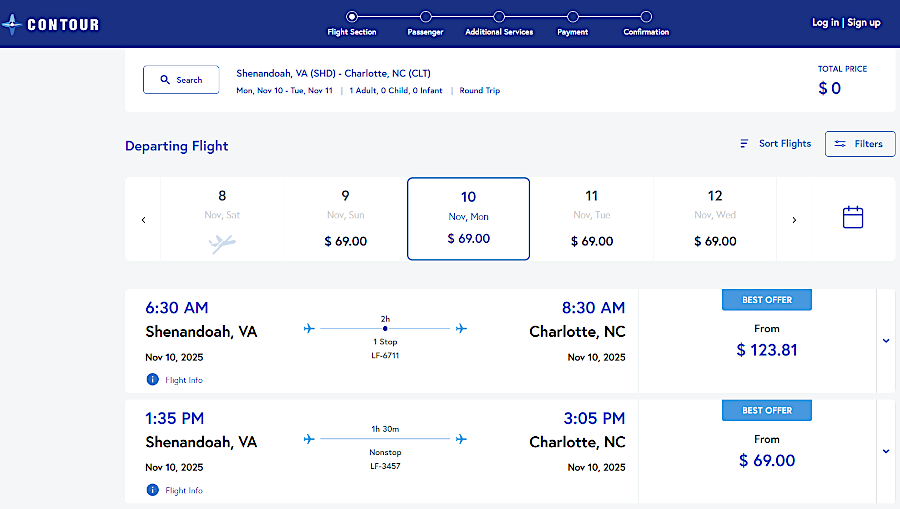
Contour Airlines offered service to Charlotte until February 2, 2026
Source: Contour Airlines, Airline Service
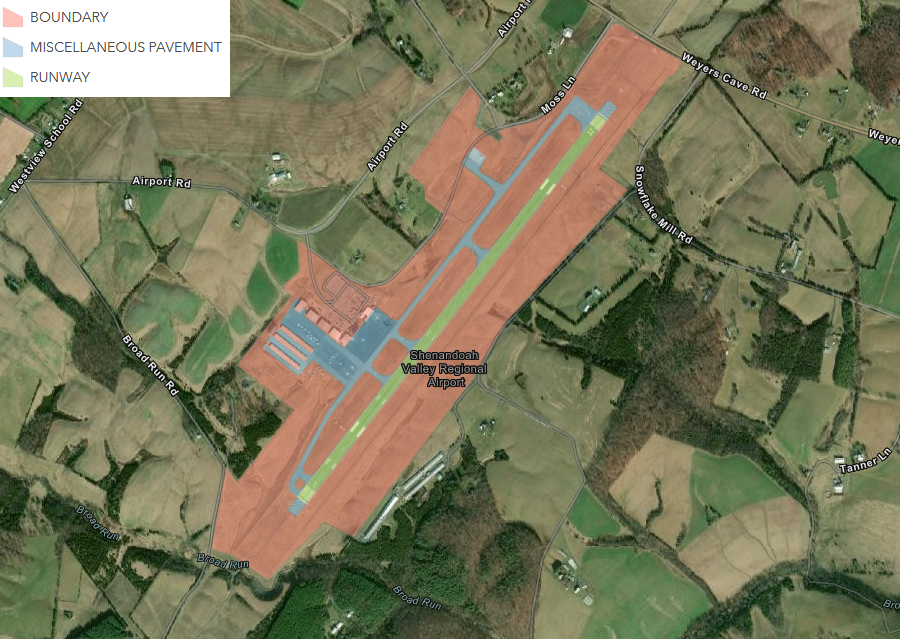
the Virginia Geographic Information Network maintains shapefiles of all airports in the state
Source: ESRI, ArcGIS Online with Virginia Airport Dataset
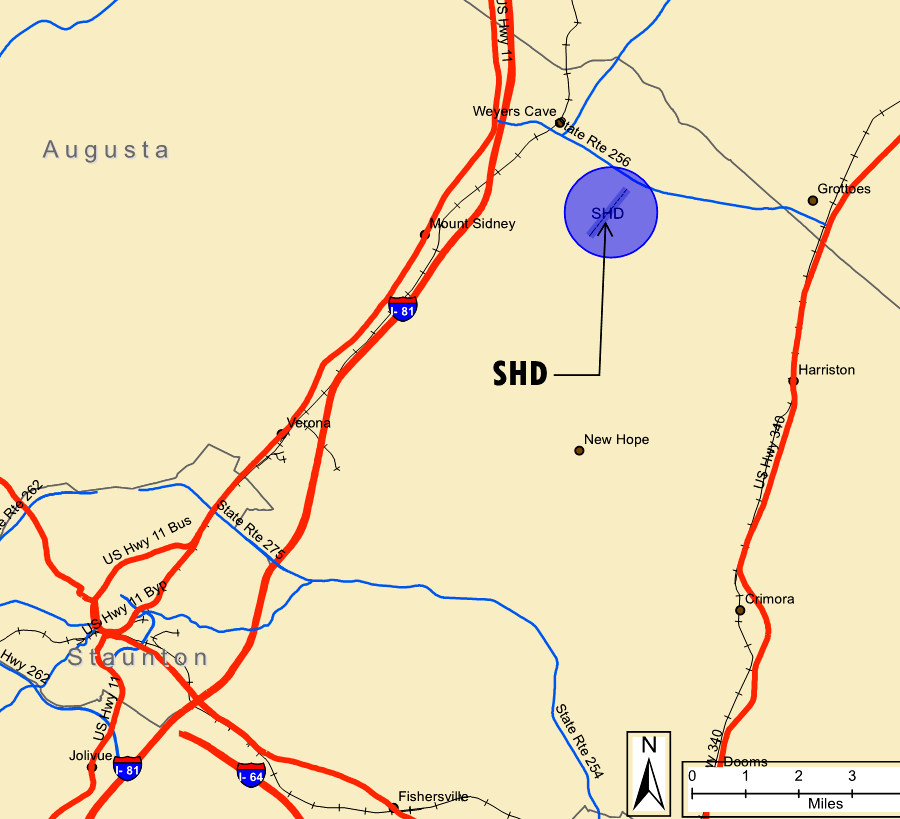
starting in 1956, Rockingham County, Augusta County, and the cities of Harrisonburg, Waynesboro and Staunton created the Shenandoah Valley Regional Airport (SHD)
Source: Shenandoah Valley Regional Airport, Master Plan Draft